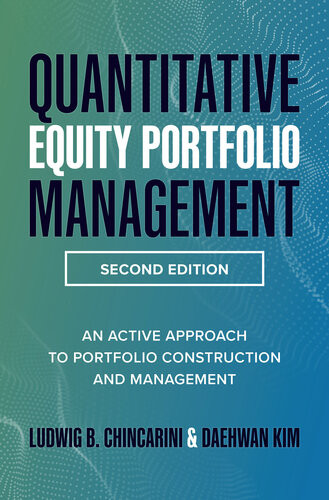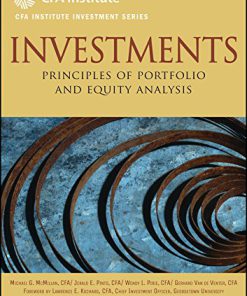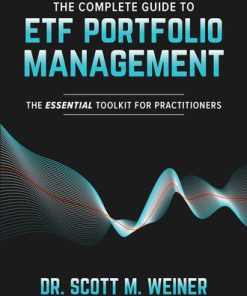Quantitative Equity Portfolio Management An Active Approach to Portfolio Construction and Management 2nd Edition by Ludwig Chincarini, Daehwan Kim 1264268939 9781264268931
$50.00 Original price was: $50.00.$25.00Current price is: $25.00.
Quantitative Equity Portfolio Management: An Active Approach to Portfolio Construction and Management 2nd Edition by Ludwig B. Chincarini, Daehwan Kim – Ebook PDF Instant Download/DeliveryISBN: 1264268939, 9781264268931
Full download Quantitative Equity Portfolio Management: An Active Approach to Portfolio Construction and Management 2nd Edition after payment.

Product details:
ISBN-10 : 1264268939
ISBN-13 : 9781264268931
Author : Ludwig B. Chincarini, Daehwan Kim
Construct and manage a high-performance equity portfolio using today’s most powerful quantitative methods The classic guide that taught a generation of investors how to build high-yield quant portfolios, Quantitative Equity Portfolio Management has been fully updated with new data, research, information, and insights, along with the latest, most powerful quantitative tools and methods. Renowned quant experts Ludwig Chincarini and Daehwan Kim walk you through the foundational principles of quantitative active management and explain how to build an equity portfolio using those powerful concepts. They provide clear explanations of all the topics you need to know—from basic models, factors and factor choice, and stock screening and ranking to fundamental factor models, economic factor models, and forecasting factor premiums and exposures. Inside, you’ll find: Proven methodology for creating an equity portfolio that maximizes returns and minimizes risks Techniques for to create a professionally managed portfolio Practical melding of financial theory with real-world practice Illustrative financial examples and case studies Every chapter has accompanying practical problems with solutions and labs using real data available online. In addition, the book as a whole has online appendices covering a brief history of financial theory, fundamental models of stock returns, a basic review of mathematical and statistical concepts, an entertaining explanation and quantitative approach to the casino game of craps, and other on-target supplemental materials. Quantitative Equity Portfolio Management delivers everything you need to build a solid equity portfolio for your clients.
Quantitative Equity Portfolio Management: An Active Approach to Portfolio Construction and Management 2nd Table of contents:
I. An Overview of QEPM
1. The Power of QEPM
1.1 Introduction
1.2 The Advantages of QEPM
1.3 Quantitative and Qualitative Approaches to Similar Investment Situations
1.4 A Tour of the Book
1.5 Conclusion
2. The Fundamentals of QEPM
2.1 Introduction
2.2 QEPM α
2.2.1 Benchmark α
2.2.2 CAPM α
2.2.3 Multifactor α
2.2.4 A Variety of α’s
2.2.5 Ex-Ante and Ex-Post α
2.2.6 Ex-Ante and Ex-Post Information Ratio
2.3 The Seven Tenets of QEPM
2.4 Tenets 1 and 2: Market Efficiency and Qepm
2.4.1 The Efficient-Market Hypothesis
2.4.2 Anomalies
2.4.3 Market Efficiency and QEPM
2.5 Tenets 3 and 4: The Fundamental Law, the Information Criterion, and Qepm
2.5.1 The Truth about the Fundamental Law
2.5.2 The Information Criterion
2.5.3 Information Loss
2.6 Tenets 5, 6, and 7: Statistical Issues in QEPM
2.6.1 Data Mining
2.6.2 Parameter Stability
2.6.3 Parameter Uncertainty
2.7 Conclusion
3. Basic QEPM Models
3.1 Introduction
3.2 Basic QEPM Models and Portfolio Construction Procedures
3.2.1 Factor Choice
3.2.2 The Data Decision
3.2.3 Factor Exposure
3.2.4 Factor Premium
3.2.5 Expected Return
3.2.6 Risk
3.2.7 Forecasting
3.2.8 Security Weighting
3.3 The Equivalence of the Basic Models
3.4 The Screening and Ranking of Stocks with the Z-Score
3.5 Hybrids of the Models and the Information Criterion
3.5.1 The Setup
3.5.2 The Z-Score Model
3.5.3 A Hybrid of the Z-Score Model and a Fundamental Factor Model
3.5.4 Information Loss
3.6 Choosing the Right Model
3.6.1 Consistency with Economic Theory
3.6.2 Ability to Combine Different Types of Factors
3.6.3 Ease of Implementation
3.6.4 Data Requirement
3.6.5 Intuitive Appeal
3.7 Conclusion
II. Portfolio Construction and Maintenance
4. Factors and Factor Choice
4.1 Introduction
4.2 Fundamental Factors
4.2.1 Valuation Factors
4.2.2 Size Factors
4.2.3 Operating Efficiency Factors
4.2.4 Operating Profitability Factors
4.2.5 Solvency Factors
4.4.6 Financial Risk Factors
4.2.7 Corporate Activity Factors
4.3 Technical Factors
4.3.1 Liquidity Risk Factors
4.3.2 Price-Based Factors
4.3.3 Volume-Based Factors
4.3.4 Overall Market Movement Factors
4.4 Economic Factors
4.5 Alternative Factors
4.5.1 Analyst Factors
4.5.2 Captivus Factors
4.5.3 Social Responsibility Factors
4.6 Factor Choice
4.6.1 Univariate Regression Tests
4.6.2 Multiple Regression Tests
4.6.3 Unidimensional Zero-Investment Portfolio
4.6.4 Multidimensional Zero-Investment Portfolio
4.6.5 Techniques to Reduce the Number of Factors
4.7 Conclusion
Appendix 4A: Factor Definition Tables
Appendix 4B: On Data Mining and Techniques to Adjust the Significance of Factors
4B.1 The Bonferroni-Type Adjustment
4B.2 A Bayesian Adjustment
5. Stock Screening and Ranking
5.1 Introduction
5.2 Sequential Stock Screening
5.3 Sequential Screens Based on Famous Strategies
5.4 Simultaneous Screening and the Aggregate Z-Score
5.4.1 The Z-Score
5.4.2 The Aggregate Z-Score
5.4.3 Ad Hoc Aggregate Z-Score
5.4.4 Optimal Aggregate Z-Score
5.4.5 Factor Groups and the Aggregate Z-Score
5.5 The Aggregate Z-Score and Expected Return
5.5.1 Expected Return Implied by the Z-Score
5.5.2 Forecasting Rule of Thumb
5.5.3 The Equivalence between the Z-Score Model and the Fundamental Factor Model
5.6 The Aggregate Z-Score and the Multifactor α
5.7 Conclusion
Appendix 5A: A List of Stock Screens Based on Well-Known Strategies
Appendix 5B: On Outliers
5B.1 General Concepts
5B.2 Specific Practical Techniques
5B.2.1 Utilizing the Z-Score
5B.2.2 The Interquartile Method
5B.2.3 The Ranking Method
5B.2.4 The Percentile Ranking Method
Appendix 5C: Converting Z-Scores to Returns
5C.1 A Numerical Example
6. Fundamental Factor Models
6.1 Introduction
6.2 Preliminary Work
6.2.1 Choosing Factors
6.2.2 Treatment of the Risk-Free Rate
6.2.3 Choosing the Time Interval and Time Period
6.2.4 Choosing the Universe of Stocks
6.3 Benchmark and α
6.4 Factor Exposure
6.5 The Factor Premium
6.5.1 OLS Estimator of the Factor Premium
6.5.2 Robustness Check
6.5.3 Outliers and MAD Estimator of Factor Premium
6.5.4 Heteroscedasticity- and Autocorrelation-Consistent Estimation of the Standard Error
6.6 Decomposition of Risk
6.7 Conclusion
7. Economic Factor Models
7.1 Introduction
7.2 Preliminary Work
7.3 Benchmark and α
7.4 The Factor Premium
7.4.1 Factor Premium for Economic/Behavioral/Market Factors
7.4.2 Factor Premium for Fundamental/Technical/Analyst Factors
7.4.3 Factor Premium for Statistical Factors
7.5 Factor Exposure
7.5.1 The Standard Approach
7.5.2 When the Standard Approach Fails
7.6 Decomposition of Risk
7.6.1 The Standard Approach
7.6.2 When the Standard Approach Fails
7.7 Conclusion
8. Forecasting Factor Premiums and Exposures
8.1 Introduction
8.2 When Is Forecasting Necessary?
8.3 Combining External Forecasts
8.4 Model-Based Forecast
8.5 Econometric Forecast
8.6 Parameter Uncertainty
8.7 Forecasting the Stock Return
8.8 Conclusion
9. Portfolio Weights
9.1 Introduction
9.2 Ad Hoc Methods
9.3 Standard Mean-Variance Optimization
9.3.1 No Constraints
9.3.2 Short-Sale and Diversification Constraints
9.3.3 Sector or Industry Constraints
9.3.4 Trading-Volume Constraint
9.3.5 Risk-Adjusted Return
9.4 Benchmark
9.5 Ad Hoc Methods Again
9.6 Stratification
9.7 Factor Exposure Targeting
9.8 Tracking-Error Minimization
9.8.1 Direct Computation
9.8.2 Tracking by Factor Exposure
9.8.3 Ghost Benchmark Tracking
9.8.4 Risk-Adjusted Tracking Error
9.9 Conclusion
Appendix 9A: Quadratic Programming
9A.1 Quadratic Programming with Equality Constraints
9A.1.1 A Numerical Example
9A.2 Quadratic Programming With Inequality Constraints
9A.2.1 A Numerical Example
Appendix 9B: Advanced Techniques for Quadratic Optimization
9B.1 Phantom Weights
9B.2 Binary Weights
9B.3 Quadratic Constraints
9B.4 Practical Examples
9B.4.1 Market Neutrality with Leverage Constraints
9B.4.2 Transactions Costs
9B.4.3 Elimination of Small-Weight Stocks
9B.4.4 Restricting the Number of Stocks
10. Rebalancing and Transactions Costs
10.1 Introduction
10.2 The Rebalancing Decision
10.2.1 Rebalancing and Model Periodicity
10.2.2 Change in α and Other Parameters
10.3 Understanding Transactions Costs
10.4 Modeling Transactions Costs
10.5 Portfolio Construction With Transactions Costs
10.5.1 The Optimal Portfolio with Transactions Costs
10.5.2 The Tracking Portfolio with Transactions Costs
10.6 Dealing with Cash Flows
10.6.1 Reducing Transactions Costs Using Futures and ETFs
10.6.2 Rebalancing toward Optimal Target Weights
10.7 Conclusion
Appendix 10A: Approximate Solution to the Optimal Portfolio Problem
Appendix 10B: An Exact Solution to the Optimal Portfolio Problem
10B.1 A Numerical Example
Appendix 10C: An Approximate Optimal Portfolio with Market Impact Costs
10C.1 Approximation of Transactions Costs
10C.2 Long-Only Portfolio
10C.3 Market-Neutral Portfolio
10C.4 Market Impact during Rebalancing
10C.5 A Numerical Example
11. Tax Management
11.1 Introduction
11.2 Dividends, Capital Gains, and Capital Losses
11.3 Principles of Tax Management
11.4 Dividend Management
11.5 Tax-Lot Management
11.6 Tax-Lot Mathematics
11.7 Capital Gain and Loss Management
11.8 Loss Harvesting
11.8.1 Loss Harvesting and Reoptimizing
11.8.2 Loss Harvesting and Characteristic Matching
11.8.3 Loss Harvesting with a Benchmark
11.9 Gains from Tax Management
11.10 Conclusion
III. α Mojo
12. Leverage
12.1 Introduction
12.2 Cash and Index Futures
12.2.1 Theoretical Limits of Leverage
12.2.2 Leverage Mechanics
12.2.3 Expected Return and Risk
12.3 Stocks, Cash, and Index Futures
12.3.1 Theoretical Limits to Leverage
12.3.2 Leverage Mechanics
12.3.3 Expected Returns and Risk
12.4 Stocks, Cash, and Single-Stock Futures
12.4.1 Theoretical Limits of Leverage
12.4.2 Leverage Mechanics
12.4.3 Expected Returns, Risk, and α Mojo
12.5 Stocks, Cash, Individual Stocks, and Single-Stock and Basket Swaps
12.5.1 Margining Individual Stocks
12.5.2 Single-Stock and Basket Swaps
12.6 Stocks, Cash, and Options
12.7 Rebalancing
12.7.1 Cash and Futures
12.7.2 Stocks, Cash, and Futures
12.8 Liquidity Buffering
12.9 Leveraged Short
12.10 Conclusion
Appendix 12A: Fair-Value Computations
Appendix 12B: Derivation of Equations (12.21), (12.22), and (12.23)
Appendix 12C: Tables of Futures Leverage Multipliers Needed to Achieve Various Degrees of Leverage
13. Market Neutral
13.1 Introduction
13.2 Market-Neutral Construction
13.2.1 Security Selection
13.2.2 Dollar Neutrality
13.2.3 Beta Neutrality (a.k.a. Risk-Factor Neutrality)
13.2.4 Market-Neutral Portfolio Out of a Long-Only Portfolio
13.3 Market Neutral’s Mojo
13.4 The Mechanics of Market Neutral
13.4.1 Margin and Shorting
13.4.2 The Margin and Market Neutral
13.4.3 Sources of the Return
13.5 The Benefits and Drawbacks of Market Neutral
13.6 Rebalancing
13.7 General Long-Short
13.7.1 Long-Short
13.7.2 Equitization
13.7.3 Portable α
13.7.4 Pair Trading
13.8 Conclusion
Appendix 13A: Market-Neutral Portfolio Construction Techniques
13A.1 A Numerical Example
14. Bayesian α
14.1 Introduction
14.2 The Basics of Bayesian Theory
14.3 Bayesian α Mojo
14.4 Quantifying Qualitative Information
14.4.1 Quantifying a Stock Screen
14.4.2 Quantifying a Stock Ranking
14.4.3 Quantifying the Buy and Sell Recommendations
14.5 The Z-Score-Based Prior
14.6 Scenario-Based Priors
14.7 Posterior Computation
14.8 The Information Criterion and Bayesian α
14.9 Conclusion
IV. Performance Analysis
15. Performance Measurement and Attribution
15.1 Introduction
15.2 Measuring Returns
15.2.1 No Cash Flows
15.2.2 Inflows and Outflows
15.2.3 Measuring Returns for Market-Neutral and Leveraged Portfolios
15.3 Measuring Risk
15.3.1 Standard Deviation
15.3.2 Semi–Standard Deviation
15.3.3 Tracking Error
15.3.4 CAPM β
15.3.5 Value-at-Risk
15.3.6 Covariance and Correlation
15.4 Risk-Adjusted Performance Measurement
15.4.1 The Sharpe Ratio
15.4.2 The Information Ratio
15.4.3 The CAPM α and the Benchmark α
15.4.4 The Multifactor α
15.4.5 Practical Issues with Risk-Adjusted Measures
15.5 Performance Attribution
15.5.1 Classical Attribution
15.5.2 Multifactor QEPM Attribution
15.6 Conclusion
Appendix 15A: Style Analysis
Appendix 15B: Measures of Opportunity
Appendix 15C: Short Returns
15C.1 A Numerical Example
Appendix 15D: Measuring Market Timing Ability
V. Practical Application
16. The Backtesting Process
16.1 Introduction
16.2 The Data and Software
16.3 The Time Period
16.4 The Investment Universe and the Benchmark
16.4.1 U.S. Equity Benchmarks
16.4.2 A Comparison of the Major U.S. Equity Benchmarks
16.4.3 The Most Popular Benchmarks and Our Benchmarks
16.5 The Factors
16.6 The Stock Return and Risk Models
16.7 Parameter Stability and the Rebalancing Frequency
16.8 The Various Types of Constructed Portfolios
16.8.1 Transaction Costs
16.8.2 Taxes
16.8.3 Leverage
16.8.4 Market-Neutral
16.9 Conclusion
Appendix 16A: Factor Formulas
17. The Portfolios’ Performance
17.1 Introduction
17.2 The Performance of the Baseline Portfolio and Variations
17.2.1 The Fundamental Factor Model Performance
17.2.2 The Aggregate Z-Score Model Performance
17.2.3 The Economic Factor Model Performance
17.2.4 Performance Reports for Distribution
17.2.5 Performance Attribution for the Fundamental Factor Model Baseline Portfolio
17.3 The Transactions Cost–Managed Portfolio Performance
17.4 The Tax-Managed Portfolio Performance
17.5 The Leveraged Portfolio Performance
17.6 The Market-Neutral Portfolio Performance
17.7 Conclusion
People also search for Quantitative Equity Portfolio Management: An Active Approach to Portfolio Construction and Management 2nd:
quantitative equity portfolio management book
quantitative equity portfolio management chincarini pdf
quantitative equity portfolio management second edition
quantitative equity portfolio management by chincarini and kim
quantitative equity portfolio management modern techniques and applications
Tags: Quantitative Equity, Portfolio Management, Active Approach, Portfolio Construction, Management, Ludwig Chincarini, Daehwan Kim
You may also like…
Business & Economics - Investing
Uncategorized
Business & Economics - Personal Finance
Business & Economics
Uncategorized
Business & Economics - Management & Leadership
Business & Economics - Management & Leadership
An Introduction to Management Science: Quantitative Approach 15th Edition David R. Anderson












